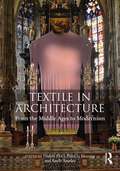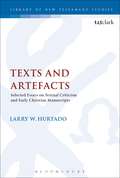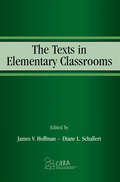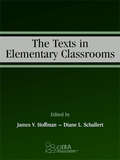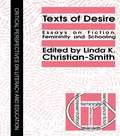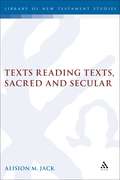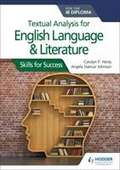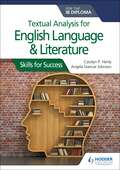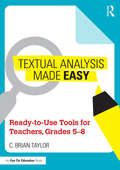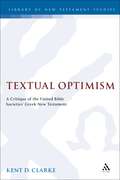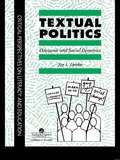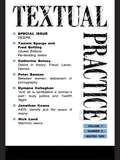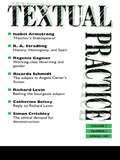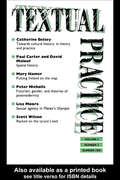- Table View
- List View
Textbooks in School and Society: An Annotated Bibliography & Guide to Research (Garland Bibliographies in Contemporary Education)
by Arthur Woodward David L. Elliot Kathleen Carter NagelFirst published in 1988. Routledge is an imprint of Taylor & Francis, an informa company.
Textbooks in School and Society: An Annotated Bibliography & Guide to Research (Garland Bibliographies in Contemporary Education)
by Arthur Woodward David L. Elliot Kathleen Carter NagelFirst published in 1988. Routledge is an imprint of Taylor & Francis, an informa company.
Textile and Fashion Education Internationalization: A Promising Discipline from Southeast Asia (Textile Science and Clothing Technology)
by Hafeezullah Memon Xinfeng Yan Lihong ChenThis book explains the past, present, and future of textile, fashion, apparel, and related majors of South Asian countries. The chapters express the hidden potential of textiles in South Asia. In this book, experts in textile engineering of each country describe the potential and prospects of textile education and how it can lead to internationalization. The book contains updated new illustrations, images, data, graphs, and tables. It also discusses the textile university alliance and the potential for international education related to textiles in the developing region.
Textile Bildung im Zeitalter der Digitalisierung: Vermittlungschancen zwischen Handarbeit und Technisierung (Pädagogik)
by Sybille WiescholekIn die Bettdecke einrollen - Gedanken verknüpfen - einen losen Faden aus der Naht ziehen. Das Textile steht unter Spannung zwischen Omnipräsenz (Allgegenwärtigkeit) und Exteriorisierung (Auslagerung). Vor dem Hintergrund dieses Spannungsfeldes, der Marginalisierung des Textilen und des niedrigen Stellenwertes des Textilen in Erziehung, Bildung und Unterricht, fragt Sybille Wiescholek: Welche Chancen des Textilen finden sich in alltäglichen Lebenszusammenhängen für den Menschen? Wie kann insbesondere der Erhalt und die Aufwertung des Textilen für Kinder und Jugendliche in aktuellen Bildungskontexten, wie Inklusion und Digitalisierung, thematisiert werden?
Textile in Architecture: From the Middle Ages to Modernism
by Didem Ekici Patricia Blessing Basile BaudezThis book investigates the interconnections between textile and architecture via a variety of case studies from the Middle Ages through the twentieth century and from diverse geographic contexts. Among the oldest human technologies, building and weaving have intertwined histories. Textile structures go back to Palaeolithic times and are still in use today and textile furnishings have long been used in interiors. Beyond its use as a material, textile has offered a captivating model and metaphor for architecture through its ability to enclose, tie together, weave, communicate, and adorn. Recently, architects have shown a renewed interest in the textile medium due to the use of computer-aided design, digital fabrication, and innovative materials and engineering. The essays edited and compiled here, work across disciplines to provide new insights into the enduring relationship between textiles and architecture. The contributors critically explore the spatial and material qualities of textiles as well as cultural and political significance of textile artifacts, patterns, and metaphors in architecture. Textile in Architecture is organized into three sections: “Ritual Spaces,” which examines the role of textiles in the formation and performance of socio-political, religious, and civic rituals; “Public and Private Interiors” explores how textiles transformed interiors corresponding to changing aesthetics, cultural values, and material practices; and “Materiality and Material Translations,” which considers textile as metaphor and model in the materiality of built environment. Including cases from Morocco, Samoa, France, India, the UK, Spain, the Ancient Andes and the Ottoman Empire, this is essential reading for any student or researcher interested in textiles in architecture through the ages.
Textile in Architecture: From the Middle Ages to Modernism
by Didem Ekici Patricia Blessing Basile BaudezThis book investigates the interconnections between textile and architecture via a variety of case studies from the Middle Ages through the twentieth century and from diverse geographic contexts. Among the oldest human technologies, building and weaving have intertwined histories. Textile structures go back to Palaeolithic times and are still in use today and textile furnishings have long been used in interiors. Beyond its use as a material, textile has offered a captivating model and metaphor for architecture through its ability to enclose, tie together, weave, communicate, and adorn. Recently, architects have shown a renewed interest in the textile medium due to the use of computer-aided design, digital fabrication, and innovative materials and engineering. The essays edited and compiled here, work across disciplines to provide new insights into the enduring relationship between textiles and architecture. The contributors critically explore the spatial and material qualities of textiles as well as cultural and political significance of textile artifacts, patterns, and metaphors in architecture. Textile in Architecture is organized into three sections: “Ritual Spaces,” which examines the role of textiles in the formation and performance of socio-political, religious, and civic rituals; “Public and Private Interiors” explores how textiles transformed interiors corresponding to changing aesthetics, cultural values, and material practices; and “Materiality and Material Translations,” which considers textile as metaphor and model in the materiality of built environment. Including cases from Morocco, Samoa, France, India, the UK, Spain, the Ancient Andes and the Ottoman Empire, this is essential reading for any student or researcher interested in textiles in architecture through the ages.
Textile Industry and the SDGs: Exploring Synergies for a Better Future (SDGs and Textiles)
by José Fernando Gallego-Nicholls Agustín Carrilero-CastilloThis book offers an exploration of the textile industry and their relationship to the Sustainable Development Goals (SDGs), catering specifically to academic researchers and providing a roadmap for aligning aligning textile research with the SDGs. It covers a wide range of topics, starting with an overview of the SDGs and their relevance to the textile industry. It examines the environmental footprint of textiles, including issues related to raw material sourcing, manufacturing processes, and waste management. Additionally, it explores the social and economic aspects of textiles, such as labor conditions, fair trade, and responsible consumption. One of the main focuses of this book is the role of innovation and technology in advancing sustainable textiles. It discusses emerging materials and technologies that promote circularity, reduce environmental harm, and enhance social well-being. Furthermore, it explores the potential of digitalization, artificial intelligence, and data analytics in optimizing textile production, distribution, and consumption patterns. This book also addresses the challenges and opportunities associated with sustainable textile supply chains. It analyzes the complexities of global value chains, the need for transparency and traceability, and the importance of collaboration among stakeholders. Furthermore, it highlights strategies for promoting sustainable fashion, encouraging responsible consumption, and fostering circular business models. By delving into these topics, this book aims to solve several key problems faced by academic researchers in the field of textiles and sustainability. It provides a holistic understanding of the SDGs and their integration into textile research, helping researchers align their work with broader sustainability objectives. It offers insights into the latest innovations and technologies, enabling researchers to explore cutting-edge solutions for sustainable textiles. Additionally, it presents case studies and best practices from industry leaders, inspiring researchers to undertake impactful research and contribute to positive change. This book is intended for academic researchers, as well as practitioners, specializing in textiles, sustainability, and related fields. It serves as a valuable resource for professors, postgraduate students, and professionals seeking to deepen their knowledge of the interplay between textiles and the SDGs. It encourages critical thinking, fosters interdisciplinary collaboration, and equips researchers with the tools and insights necessary to drive sustainable transformations within the textile industry and beyond.
Textiles: Pearson New International Edition
by Sara kadolphFor courses in Textile Science, Textile Fundamentals, Introduction to Textiles, Textiles for Interiors, or other courses that focus on basic textiles. A revered resource, Textiles, 11th Edition, by Sara Kadolph, provides students with a basic knowledge of textiles, how they are produced and how appropriate performance characteristics are incorporated into materials and products. Organised according to the textile production process, the text provides a solid understanding of textile components—including fibers, yarns, fabrics, and finishes. Using new full-colour photos and illustrations, it examines the interrelationships among these components and their impact on product performance. This edition features coverage of new fibers, updated industry and company examples and summary tables that make this a timeless resource for any industry professional. Also discusses the new effects of sustainablity in the industry. The full text downloaded to your computer With eBooks you can: search for key concepts, words and phrases make highlights and notes as you study share your notes with friends eBooks are downloaded to your computer and accessible either offline through the Bookshelf (available as a free download), available online and also via the iPad and Android apps. Upon purchase, you'll gain instant access to this eBook. Time limit The eBooks products do not have an expiry date. You will continue to access your digital ebook products whilst you have your Bookshelf installed.
Texts and Artefacts: Selected Essays on Textual Criticism and Early Christian Manuscripts (The Library of New Testament Studies)
by Larry W. HurtadoThe essays included in this volume present Larry W. Hurtado's steadfast analysis of the earliest Christian manuscripts. In these chapters, Hurtado considers not only standard text-critical issues which seek to uncover an earliest possible version of a text, but also the very manuscripts that are available to us. As one of the pre-eminent scholars of the field, Hurtado examines often overlooked 2nd and 3rd century artefacts, which are among the earliest manuscripts available, drawing fascinating conclusions about the features of early Christianity. Divided into two halves, the first part of the volume addresses text-critical and text-historical issues about the textual transmission of various New Testament writings. The second part looks at manuscripts as physical and visual artefacts themselves, exploring the metadata and sociology of their context and the nature of their first readers, for the light cast upon early Christianity. Whilst these essays are presented together here as a republished collection, Hurtado has made several updates across the collection to draw them together and to reflect on the developing nature of the issues that they address since they were first written.
The Texts in Elementary Classrooms
by James V. Hoffman Diane L. SchallertThis CIERA sponsored book is based on the premise that high-quality texts of all kinds are essential to good teaching in elementary classrooms. Experts on a variety of text-related topics were asked to summarize existing research and then apply it to literacy development in an "ideal" classroom. The most comprehensive and up-to-date book in its field, it moves progressively from an examination of discrete literacy processes and forms to a holistic overview and assessment of the classroom literacy environment. Content coverage in this outstanding new book includes: *Literacy Processes--Part I examines basic reading processes (instruction, comprehension, word recognition, fluency, and motivation) as they relate to text features.*Forms of Texts--Part II examines the wide variety of text types (fiction, nonfiction, leveled, local, and electronic) that comprise an effective classroom literacy program. Discussions include the nature of these texts, their qualities and quantities, how they fit into an instructional plan, and how a teacher might assess their effectiveness.*Text Selection--Part III examines special issues (linguistic diversity and teachers as censors) related to the selection of classroom texts.*Personal Applications--The final, hands-on chapter synthesizes the book's ideas and offers practical tools (checklists and inventories) whereby teachers can self-assess the literacy environment of their own classrooms.This book is suitable for anyone (graduate students, in-service reading specialists and curriculum directors, college faculty, and researchers) who deal directly with issues of classroom literacy.
The Texts in Elementary Classrooms
by James V. Hoffman Diane Lemonnier SchallertThis CIERA sponsored book is based on the premise that high-quality texts of all kinds are essential to good teaching in elementary classrooms. Experts on a variety of text-related topics were asked to summarize existing research and then apply it to literacy development in an "ideal" classroom. The most comprehensive and up-to-date book in its field, it moves progressively from an examination of discrete literacy processes and forms to a holistic overview and assessment of the classroom literacy environment. Content coverage in this outstanding new book includes: *Literacy Processes--Part I examines basic reading processes (instruction, comprehension, word recognition, fluency, and motivation) as they relate to text features.*Forms of Texts--Part II examines the wide variety of text types (fiction, nonfiction, leveled, local, and electronic) that comprise an effective classroom literacy program. Discussions include the nature of these texts, their qualities and quantities, how they fit into an instructional plan, and how a teacher might assess their effectiveness.*Text Selection--Part III examines special issues (linguistic diversity and teachers as censors) related to the selection of classroom texts.*Personal Applications--The final, hands-on chapter synthesizes the book's ideas and offers practical tools (checklists and inventories) whereby teachers can self-assess the literacy environment of their own classrooms.This book is suitable for anyone (graduate students, in-service reading specialists and curriculum directors, college faculty, and researchers) who deal directly with issues of classroom literacy.
Texts Of Desire: Essays Of Fiction, Femininity And Schooling
by Linda K. Christian-SmithFirst published in 1993. Routledge is an imprint of Taylor & Francis, an informa company.
Texts Of Desire: Essays Of Fiction, Femininity And Schooling
by Linda K. Christian-SmithFirst published in 1993. Routledge is an imprint of Taylor & Francis, an informa company.
Texts Reading Texts, Sacred and Secular: Two Postmodern Perspectives (The Library of New Testament Studies #179)
by Alison JackThe language, themes and imagery of the Bible have been rewritten into texts across time. In the Revelation of John, the Hebrew Bible echoes and is reinvented, just as in James Hogg's The Private Memoirs and Confessions of a Justified Sinner (1824) many explicit and implicit readings and interpretations of the Bible are offered. In Texts Reading Texts, these readings of the Bible, and the ways in which Revelation and Hogg's Confessions have themselves been read, are considered from the two postmodern perspectives of marginalization and deconstruction. By reading the two seemingly unrelated texts side by side from these perspectives, traditional readings of them both are disturbed and challenged.
Textual analysis for English Language and Literature for the IB Diploma: Skills for Success
by Carolyn P. Henly Angela Stancar JohnsonBuild confidence in a range of key textual analysis techniques and skills with this practical companion, full of advice and guidance from experienced experts.- Build analysis techniques and skills through a range of strategies, serving as a useful companion throughout the course - from critical-thinking, referencing and citation and the development of a line of inquiry to reflecting on the writing process and constructing essays for Paper 1 and Paper 2- Develop skills in how to approach a text using textual analysis strategies and critical theory, for both unseen texts (the basis of Paper 1) and texts studied in class- Concise, clear explanations help students navigate the IB requirements, including advice on assessment objectives and how literary and textual analysis weaves through Paper 1, Paper 2, the HL Essay, Individual Oral and the Learner Profile- Build understanding in how to approach texts so that students can write convincingly and passionately about texts through active reading, note-taking, asking questions, and developing a personal response to texts - Engaging activities are provided to test understanding of each topic and develop skills for the exam - guiding answers are available to check your responses
Textual analysis for English Language and Literature for the IB Diploma: Skills for Success
by Carolyn P. Henly Angela Stancar JohnsonBuild confidence in a range of key textual analysis techniques and skills with this practical companion, full of advice and guidance from experienced experts.- Build analysis techniques and skills through a range of strategies, serving as a useful companion throughout the course - from critical-thinking, referencing and citation and the development of a line of inquiry to reflecting on the writing process and constructing essays for Paper 1 and Paper 2- Develop skills in how to approach a text using textual analysis strategies and critical theory, for both unseen texts (the basis of Paper 1) and texts studied in class- Concise, clear explanations help students navigate the IB requirements, including advice on assessment objectives and how literary and textual analysis weaves through Paper 1, Paper 2, the HL Essay, Individual Oral and the Learner Profile- Build understanding in how to approach texts so that students can write convincingly and passionately about texts through active reading, note-taking, asking questions, and developing a personal response to texts - Engaging activities are provided to test understanding of each topic and develop skills for the exam - guiding answers are available to check your responses
Textual Analysis Made Easy: Ready-to-Use Tools for Teachers, Grades 5-8
by C. Brian TaylorIn this new book, you’ll learn how to teach evidence-based writing using a variety of tools, activities, and sample literary texts. Showing elementary and middle school students how to think critically about what they’re reading can be a challenge, but author C. Brian Taylor makes it easy by presenting twelve critical thinking tools along with step-by-step instructions for implementing each one effectively in the classroom. You’ll learn how to: Design units and lesson plans that gradually introduce your students to more complex levels of textual analysis; Encourage students to dig deeper by using the 12 Tools for Critical Thinking; Help students identify context and analyze quotes with the Evidence Finder graphic organizer; Use the Secret Recipe strategy to construct persuasive evidence-based responses that analyze a text’s content or technique; Create Cue Cards to teach students how to recognize and define common literary devices. The book also offers a series of extra examples using mentor texts, so you can clearly see how the strategies in this book can be applied to excerpts from popular, canonical, and semi-historical literature. Additionally, a number of the tools and templates in the book are available as free eResources from our website (http://www.routledge.com/9781138950658), so you can start using them immediately in your classroom.
Textual Analysis Made Easy: Ready-to-Use Tools for Teachers, Grades 5-8
by C. Brian TaylorIn this new book, you’ll learn how to teach evidence-based writing using a variety of tools, activities, and sample literary texts. Showing elementary and middle school students how to think critically about what they’re reading can be a challenge, but author C. Brian Taylor makes it easy by presenting twelve critical thinking tools along with step-by-step instructions for implementing each one effectively in the classroom. You’ll learn how to: Design units and lesson plans that gradually introduce your students to more complex levels of textual analysis; Encourage students to dig deeper by using the 12 Tools for Critical Thinking; Help students identify context and analyze quotes with the Evidence Finder graphic organizer; Use the Secret Recipe strategy to construct persuasive evidence-based responses that analyze a text’s content or technique; Create Cue Cards to teach students how to recognize and define common literary devices. The book also offers a series of extra examples using mentor texts, so you can clearly see how the strategies in this book can be applied to excerpts from popular, canonical, and semi-historical literature. Additionally, a number of the tools and templates in the book are available as free eResources from our website (http://www.routledge.com/9781138950658), so you can start using them immediately in your classroom.
Textual Optimism: A Critique of the United Bible Societies' Greek New Testament (The Library of New Testament Studies #138)
by Kent ClarkeClarke offers an important study of the standard text of the New Testament that is in the hands of every new Testament scholar. He compares the five editions to appear since 1966, focusing upon the textual apparatus and the A, B, C and D evaluation of evidence letter-ratings. Clarke presents the evidence of extensive 'grade inflation' in the fourth edition, implying a much higher degree of certainty than previous editions had accepted. He claims that the editors have not only been inconsistent and overly optimistic in their modifications, but have also failed to provide readers with an adequate explanation and methodological basis for these unprecedented changes.
Textual Politics: Discourse And Social Dynamics
by Jay L. LemkeTexts record the meanings we make: in words, pictures and deeds, and politics chronicles our uses of power in shaping social relationships large and small. Textual politics is about meaning - the meaning we make with words and with the symbolic values of every object and action.; The book begins with an introduction which discusses the relationship between Discourse And The Notions Of Power And Ideology. These Concepts Are Then applied to major issues: the social construction of class, gender and individuality; the rhetoric of polarizing social controversies religious fundamentalism vs. gay rights; and the abuse of technical language in policy arguments educational research vs. conservative politics. The book ends with chapters which extend the theory to processes of large- scale social change and apply it to the challenges facing education and political action in the new global information century.
Textual Politics: Discourse And Social Dynamics (Critical Perspectives On Literacy And Education Ser.)
by Jay L. LemkeTexts record the meanings we make: in words, pictures and deeds, and politics chronicles our uses of power in shaping social relationships large and small. Textual politics is about meaning - the meaning we make with words and with the symbolic values of every object and action.; The book begins with an introduction which discusses the relationship between Discourse And The Notions Of Power And Ideology. These Concepts Are Then applied to major issues: the social construction of class, gender and individuality; the rhetoric of polarizing social controversies religious fundamentalism vs. gay rights; and the abuse of technical language in policy arguments educational research vs. conservative politics. The book ends with chapters which extend the theory to processes of large- scale social change and apply it to the challenges facing education and political action in the new global information century.
Textual Practice: Volume 7, Issue 3: Special Issue: Desire
by Terence HawkesFirst published in 1993. Routledge is an imprint of Taylor & Francis, an informa company.
Textual Practice: Volume 7, Issue 3: Special Issue: Desire
by Terence HawkesFirst published in 1993. Routledge is an imprint of Taylor & Francis, an informa company.
Textual Practice: Issue 7 Volume 3 No. 1
by Terence HawkesFirst Published in 1989. Routledge is an imprint of Taylor & Francis, an informa company.
Textual Practice: Issue 8 Volume 3 No. 2
by Terence HawkesThis book should be of interest to students and teachers of literature and literary theory.




